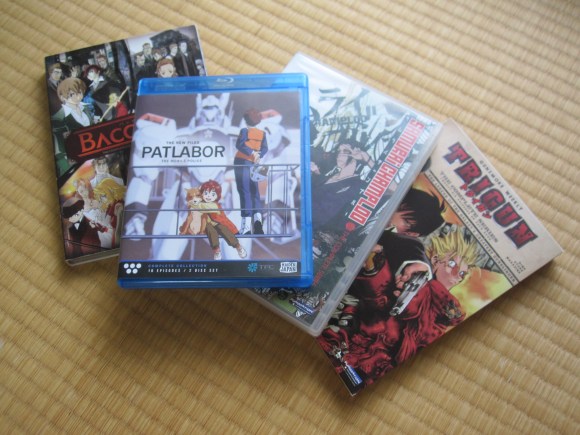
Also, do themes songs or background music leave the bigger impression?
One of the defining qualities of Japanese animation is how much meticulous effort gets poured into the various aspects of a production. That thoroughness is reflected in the medium’s fanbase, as you can find not only anime enthusiasts ready to wax poetic about the art of their favorite shows, but others who find themselves deeply affected by themes, attached to characters, or moved by music.
But ultimately what’s the most important factor in catching a fan’s interest? In search of the answer, Internet portal My Navi polled 194 anime fans currently in college, and asked them what element, if done well, has the greatest power to make a show interesting.
Let’s look at the top five responses.
5. Animation (4.1 percent)
It might feel odd to see relatively few Japanese animation fans proclaiming to be fans of, in the literal sense, animation. Still, the actual process of breaking down and drawing movement in tiny segments can be a hard thing to critique, especially if you don’t have first-hand experience trying to animate something. It takes a lot of viewing experience to be able to really appreciate all the subtleties that go into that, which might explain why this relatively young group of survey participants didn’t vote for “animation” in overwhelming numbers.
4. Realism (4.6 percent)
There’s nothing wrong with a certain degree of escapist entertainment. Still, most intense media consumers would like to think that their enjoyment of their favorite TV series and movies stems from how they speak to some sort of real-world truth with greater implications than the story unfolding within the confines of the screen.
3. Background music (5.7 percent)
While anime theme songs get the vast majority of the glory (and CD sales revenue), background music is what respondents picked for their top five. BGM may be the less flashy musical category, but it’s also the one with the greater potential to affect one’s enjoyment of the anime itself. Opening and ending themes are often designed primarily to promote a new vocalist or appeal to the singer’s preexisting fans, but background music can be crafted to accompany the emotion of individual scenes and in-story events.
2. Characters (25.8 percent)
In real life, we’re much more likely to listen to someone if we have positive feelings about them, regardless of whether or not what they’re saying is really all that interesting in and of itself. The same phenomenon holds true for anime, as nearly one in four survey participants said that if they like a series’ characters, they’re willing to come along for the ride.
This broad response covered both fans who liked a character’s personality or psychology as well as those who simply liked the way the character looked. And while that last reason might seem a little shallow, one respondent brought up the fairly convincing argument that “If the characters don’t look good, you might as well read a novel instead.”
1. Story (49 percent)
By far the most common response, though, was that an interesting story is what makes for an interesting anime. These days, almost all anime are based on a manga, illustrated novel, or video game, meaning the anime is already starting out with character designs that have resonated with a large group of fans. “There are a ton of anime with cool-looking characters,” explained one respondent, “but only a few with stories that grab you,” showing that not all anime fans are watching just for the bulbous boobs and sweaty, slim-waisted young sportsmen.
Source: My Navi Gakusei no Madoguchi via Jin
Top image ©RocketNews24
Follow Casey on Twitter, where he’d like to sincerely apologize for not being able to fit Moribito and Midori Days into that photo.

 Large portion of Japanese fans are willing to drop an anime after one bad episode, survey says
Large portion of Japanese fans are willing to drop an anime after one bad episode, survey says Japanese college students share four ways anime high school is different from real high school
Japanese college students share four ways anime high school is different from real high school Five anime/manga series praised by Japanese fans for their realistic human relationships【Survey】
Five anime/manga series praised by Japanese fans for their realistic human relationships【Survey】 Do Japanese men like it when real women speak in anime-style voices? Survey investigates
Do Japanese men like it when real women speak in anime-style voices? Survey investigates Goku down! Vast majority of surveyed college students in Japan haven’t read the Dragon Ball manga
Goku down! Vast majority of surveyed college students in Japan haven’t read the Dragon Ball manga Foreigner’s request for help in Tokyo makes us sad for the state of society
Foreigner’s request for help in Tokyo makes us sad for the state of society Historical figures get manga makeovers from artists of Spy x Family, My Hero Academia and more
Historical figures get manga makeovers from artists of Spy x Family, My Hero Academia and more Japanese city loses residents’ personal data, which was on paper being transported on a windy day
Japanese city loses residents’ personal data, which was on paper being transported on a windy day Harajuku Station’s beautiful old wooden building is set to return, with a new complex around it
Harajuku Station’s beautiful old wooden building is set to return, with a new complex around it Ghibli Park now selling “Grilled Frogs” from food cart in Valley of Witches
Ghibli Park now selling “Grilled Frogs” from food cart in Valley of Witches Heartwarming response to Twitter question confirms that yes, Tikuwa_0913, there is a Santa Claus
Heartwarming response to Twitter question confirms that yes, Tikuwa_0913, there is a Santa Claus Suntory x Super Mario collaboration creates a clever way to transform into Mario【Videos】
Suntory x Super Mario collaboration creates a clever way to transform into Mario【Videos】 Red light district sushi restaurant in Tokyo shows us just how wrong we were about it
Red light district sushi restaurant in Tokyo shows us just how wrong we were about it Japan’s cooling body wipe sheets want to help you beat the heat, but which work and which don’t?
Japan’s cooling body wipe sheets want to help you beat the heat, but which work and which don’t? We try out “Chan Ramen”, an underground type of ramen popular in the ramen community
We try out “Chan Ramen”, an underground type of ramen popular in the ramen community McDonald’s new Happy Meals offer up cute and practical Sanrio lifestyle goods
McDonald’s new Happy Meals offer up cute and practical Sanrio lifestyle goods Japanese ramen restaurants under pressure from new yen banknotes
Japanese ramen restaurants under pressure from new yen banknotes French Fries Bread in Tokyo’s Shibuya becomes a hit on social media
French Fries Bread in Tokyo’s Shibuya becomes a hit on social media Studio Ghibli releases new action figures featuring Nausicaä of the Valley of the Wind characters
Studio Ghibli releases new action figures featuring Nausicaä of the Valley of the Wind characters New private rooms on Tokaido Shinkansen change the way we travel from Tokyo to Kyoto
New private rooms on Tokaido Shinkansen change the way we travel from Tokyo to Kyoto Tokyo Tsukiji fish market site to be redeveloped with 50,000-seat stadium, hotel, shopping center
Tokyo Tsukiji fish market site to be redeveloped with 50,000-seat stadium, hotel, shopping center All-you-can-drink Starbucks and amazing views part of Tokyo’s new 170 meter-high sky lounge
All-you-can-drink Starbucks and amazing views part of Tokyo’s new 170 meter-high sky lounge Beautiful Ghibli sealing wax kits let you create accessories and elegant letter decorations【Pics】
Beautiful Ghibli sealing wax kits let you create accessories and elegant letter decorations【Pics】 Studio Ghibli releases Kiki’s Delivery Service chocolate cake pouches in Japan
Studio Ghibli releases Kiki’s Delivery Service chocolate cake pouches in Japan New definition of “Japanese whiskey” goes into effect to prevent fakes from fooling overseas buyers
New definition of “Japanese whiskey” goes into effect to prevent fakes from fooling overseas buyers Our Japanese reporter visits Costco in the U.S., finds super American and very Japanese things
Our Japanese reporter visits Costco in the U.S., finds super American and very Japanese things Studio Ghibli unveils Mother’s Day gift set that captures the love in My Neighbour Totoro
Studio Ghibli unveils Mother’s Day gift set that captures the love in My Neighbour Totoro More foreign tourists than ever before in history visited Japan last month
More foreign tourists than ever before in history visited Japan last month New Pokémon cakes let you eat your way through Pikachu and all the Eevee evolutions
New Pokémon cakes let you eat your way through Pikachu and all the Eevee evolutions Sales of Japan’s most convenient train ticket/shopping payment cards suspended indefinitely
Sales of Japan’s most convenient train ticket/shopping payment cards suspended indefinitely Sold-out Studio Ghibli desktop humidifiers are back so Totoro can help you through the dry season
Sold-out Studio Ghibli desktop humidifiers are back so Totoro can help you through the dry season Japanese government to make first change to romanization spelling rules since the 1950s
Japanese government to make first change to romanization spelling rules since the 1950s Ghibli founders Toshio Suzuki and Hayao Miyazaki contribute to Japanese whisky Totoro label design
Ghibli founders Toshio Suzuki and Hayao Miyazaki contribute to Japanese whisky Totoro label design Doraemon found buried at sea as scene from 1993 anime becomes real life【Photos】
Doraemon found buried at sea as scene from 1993 anime becomes real life【Photos】 Tokyo’s most famous Starbucks is closed
Tokyo’s most famous Starbucks is closed One Piece characters’ nationalities revealed, but fans have mixed opinions
One Piece characters’ nationalities revealed, but fans have mixed opinions We asked a Uniqlo employee what four things we should buy and their suggestions didn’t disappoint
We asked a Uniqlo employee what four things we should buy and their suggestions didn’t disappoint Princesses, fruits, and blacksmiths: Study reveals the 30 most unusual family names in Japan
Princesses, fruits, and blacksmiths: Study reveals the 30 most unusual family names in Japan The 10 best anime of the fall season, according to Japanese otaku
The 10 best anime of the fall season, according to Japanese otaku Here’s why Japanese supermarkets play “cheap” background music all day, according to Twitter
Here’s why Japanese supermarkets play “cheap” background music all day, according to Twitter The 10 best anime about idols, as chosen by the Internet masses
The 10 best anime about idols, as chosen by the Internet masses Secret backmasked message found hidden in Dragon Ball Z ending song
Secret backmasked message found hidden in Dragon Ball Z ending song Studio Ghibli finishes free-to-use image release with 250 from Nausicaa, Laputa, and more
Studio Ghibli finishes free-to-use image release with 250 from Nausicaa, Laputa, and more This Japanese schoolgirl loves anime, lollipops, and competitive pistol shooting【Video】
This Japanese schoolgirl loves anime, lollipops, and competitive pistol shooting【Video】 Anime song dance performance group Real Akiba Boys: combining the otaku life with street dancing
Anime song dance performance group Real Akiba Boys: combining the otaku life with street dancing Young Japanese singles list the organizations they’d most like a potential date to work for
Young Japanese singles list the organizations they’d most like a potential date to work for Italian jazz pianist unleashes inner Ghibli fanboy, releases anime theme song album
Italian jazz pianist unleashes inner Ghibli fanboy, releases anime theme song album Makoto Shinkai or Mamoru Hosoda, who makes the better anime movies?【Survey】
Makoto Shinkai or Mamoru Hosoda, who makes the better anime movies?【Survey】 Japan’s 25 most popular cat names
Japan’s 25 most popular cat names
Leave a Reply